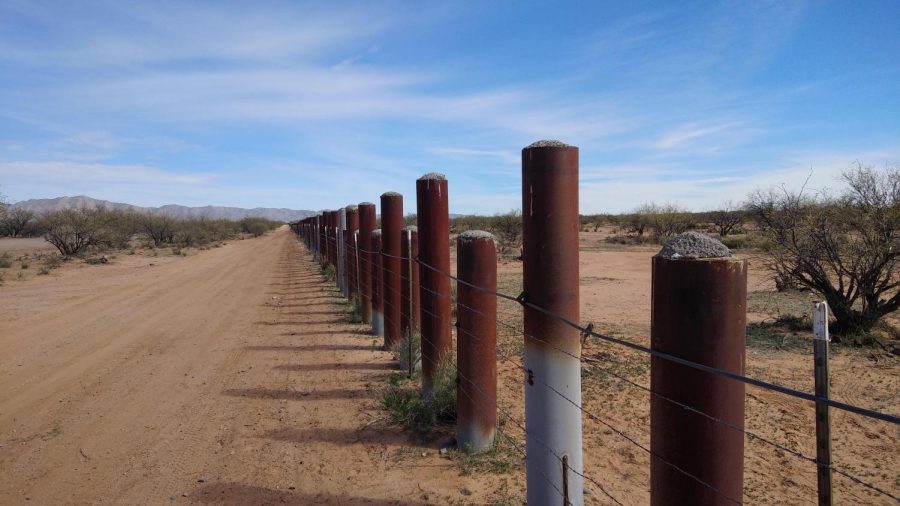Guest Column: “Standing Beside the Infamous Barrier”
April 11, 2018
The following is a guest column by Mr. Krantz, who helped lead the Arizona border immersion just before Spring Break.
For the past two years President Donald Trump has told the world that he intends to build a wall on the Mexico/US border. Someone might tell him—one already exists. At the moment, nine La Salle students and two of their teachers are standing beside the infamous barrier, contemplating its myriad social, historical and economic implications. To be accurate, the border wall currently in place is a series of non-contiguous fences which includes a system of sensors and cameras monitored by the United States Border Patrol. Of the nearly 2,000 miles that make up the US/Mexico border, about 600 miles of it have such a barrier. The remaining areas open out into some of the most difficult, least survivable terrain in the world.
To begin to understand just how complex border-related issues are, consider where the La Salle students and their teachers are standing. We are in the Sonora Desert, on the Tohono O’odham reservation, which—since 1853 as a result of the Gadsden Purchase—has been divided in half. That’s right; half of the nation exists in Mexico, the other half in the United States. You may recall that California, Arizona, New Mexico and parts of Utah and Texas were all once part of Mexico, but after the Mexican-American War, and the subsequent Treaty of Guadalupe Hidalgo (1848), Mexico was forced to give up 55% of its territory—and 5 years later, as a result of the Gadsden Purchase, the US/Mexico border got moved another 100 miles south, right smack dab in the middle of the Tohono O’odham nation. And if you don’t think this causes any problems other than a border fence running through their property, consider that immigration laws prevent the O’odham from crossing freely and thus impairing their ability to collect foods and materials needed to sustain their culture and to visit family members and traditional sacred sites.
Imagine a 32 mile dry-river basin with a mountain range on either side, and as far as we can see, nothing but desert—which means nothing but sand and cactus—the most sadistic, the jumping cholla (capable of projecting long thin needles through canvas and shoe leather), and the most majestic, the saguaro (so revered in these parts that even the direction of the border fence zig zags to accommodate its presence).
As we look along the fence—made up of foot-wide cement-filled steel posts, extending variously at six to seven feet above the ground, spaced two feet apart and connected by barbed wire—it is obvious this portion of the fence is designed to keep out desert vehicles while allowing animals such as Javalina (a kind of wild boar) and coyote to pass.
But thieves have been coming north to steal the O’odham horses and with the increased human and narcotic trafficking—especially at night—the Tohono O’odham need the border patrol more than ever. According to our guide, Daniel—a young man with the chiseled look of a great ancestral ruler (he happens to be the son of the Vice President of the Tohono O’odham nation)—his people actually support the heavy presence of the border patrol (we’d only been on the reservation a few hours and I’d already counted 23 border patrol vehicles). And from the puzzled look on students’ faces, I can see Daniel’s admission surprises them.
Just yesterday at the U.S. Border Patrol office in Nogales, we heard the scripted narrative of the border patrol (uncomfortably the same narrative I had heard on my first border immersion in 2006) justifying the patrol’s presence and use of force and, to some, questionable policies. One such policy, known as “Hold the Line” in El Paso (and similarly “Prevention Through Deterrence” in San Diego) has—since 1993—caused thousands of migrants to die in the desert and which arguably has contributed to making border crossings more difficult, thus more expensive and dangerous (migrants, for example, have been forced for years now to hire guides employed by the cartels who now control nearly all trafficking along the border and who often exploit, rape, and, abandon migrants in the desert).
But this exchange between Daniel and Officer Santino, a 17-year veteran of the U.S. Border Patrol, is startlingly different. Both men speak honestly about their need for each other, the futility of imposing one organization’s will upon the other, and the enormously complex and challenging realities. And what stands out to us in this moment along the border is the appreciation and understanding and respect each man has for the other despite these challenges.
A tribal leader, a border patrol officer, and La Salle students—standing in the middle of the Sonora Desert, just talking and listening to each other




